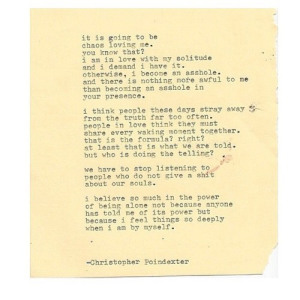P PP P PP
Pleasantly and Presently Persisting the Plangent and Pliable Polyphony
CCCCc C
Creole Crayola Crackpots Cruisicrashing and Callous-flashing.
TTTTTT T T
Thirstily Thrumpaging Through The Thick Throng of Thorn and Thistle.
Archive
CCCCc C
Creole Crayola Crackpots Cruisicrashing and Callous-flashing
P PP P PP
Pleasantly and Presently Persisting the Plangent and Pliable Polyphony
TTTTTT T T
Thirstily Thrumpaging Through The Thick Throng of Thorn and Thistle
keats | I.IV – solitude.

“There are times when I am convinced I am unfit for any human relationship.”
-Kafka, Letters to Felice
James Joyce, A Portrait of the Artist, Sitting

For most of 1928, James Joyce’s attention was unequally divided among many projects and complications: He was keeping a wary watch over German and French translations of “Ulysses,” his 1922 novel; readying sections of his next novel, which was still officially titled “Work in Progress” (published as “Finnegan’s Wake” years later, in 1939); defending “Work in Progress” from negative reviews and letters from friends who were urging him to quit his experimental writing; explaining to his patrons when new sections of “Work in Progress” could be expected so that he could have an income; and losing his eyesight.
He was 46 years old, living in Paris with his partner, Nora, and their two children, and life was complicated. He was engaged in writing the novel that became “Finnegan’s Wake,” and his artistic ambition for it and its effect on him were both unsparing. “Ulysses” tells a story of a single…
View original post 659 more words
WRITING & READING, DEMOCRACY & DESPOTISM

Two writers, two talks, two beautifully-expressed arguments about the writer and his or her responsibilities, to the reader, to the craft, to the world. The first is a talk that Philip Pullman gave at the World Humanist Congress in Oxford this summer. I was lucky enough to be in the Sheldonian Theatre to listen to it, a talk that was, as so few are, thoughtful, provocative, illuminating and inspiring all at the same time. It has been republished in the latest issue of New Humanist. When I listened to Pullman, there was a section on the relationship between the writer and the reader that particularly struck me. Re-reading it in New Humanist, it still does; so I am republishing that section here. The whole talk is worth reading, though, so do get the latest issue of New Humanist, for Philip Pullman, and much else.
The second talk was…
View original post 717 more words
In Literature, Concealing and Revealing Torture

A few days ago, the New York Times ran an op-ed from a creative-writing instructor and confessed torturer:
 “I was an interrogator at Abu Ghraib,” Eric Fair writes. “I tortured.”
“I was an interrogator at Abu Ghraib,” Eric Fair writes. “I tortured.”
But when Fair discusses his creative-writing class at Lehigh University — in conjunction with his experience as a torturer — he writes not about investigating Mahmoud Saeed’s “Lizard’s Colony” or perhaps scenes from Elias Khoury’s Yalo, but Tim O’Brien’s “The Things They Carried.” He writes about showing his students a cigar box filled with stuff he bought at the Baghdad International Airport.
Fair seems focused on keeping the issue of torture at the forefront of the American imagination, which is good. But in effect, by reading his essay, we are asked to sympathize exclusively with the torturer. We know about Eric Fair, and about his black fleece coat, and about his son, who rides a bus to school.
We don’t know about any…
View original post 745 more words
Why I am not Charlie

 There is no “but” about what happened at Charlie Hebdo yesterday. Some people published some cartoons, and some other people killed them for it. Words and pictures can be beautiful or vile, pleasing or enraging, inspiring or offensive; but they exist on a different plane from physical violence, whether you want to call that plane spirit or imagination or culture, and to meet them with violence is an offense against the spirit and imagination and culture that distinguish humans. Nothing mitigates this monstrosity. There will be time to analyze why the killers did it, time to parse their backgrounds, their ideologies, their beliefs, time for sociologists and psychologists to add to understanding. There will be explanations, and the explanations will be important, but explanations aren’t the same as excuses. Words don’t kill, they must not be met by killing, and they will not make the killers’ culpability go away.
There is no “but” about what happened at Charlie Hebdo yesterday. Some people published some cartoons, and some other people killed them for it. Words and pictures can be beautiful or vile, pleasing or enraging, inspiring or offensive; but they exist on a different plane from physical violence, whether you want to call that plane spirit or imagination or culture, and to meet them with violence is an offense against the spirit and imagination and culture that distinguish humans. Nothing mitigates this monstrosity. There will be time to analyze why the killers did it, time to parse their backgrounds, their ideologies, their beliefs, time for sociologists and psychologists to add to understanding. There will be explanations, and the explanations will be important, but explanations aren’t the same as excuses. Words don’t kill, they must not be met by killing, and they will not make the killers’ culpability go away.
To abhor what was done to the victims, though, is not…
View original post 2,316 more words


Recent Comments